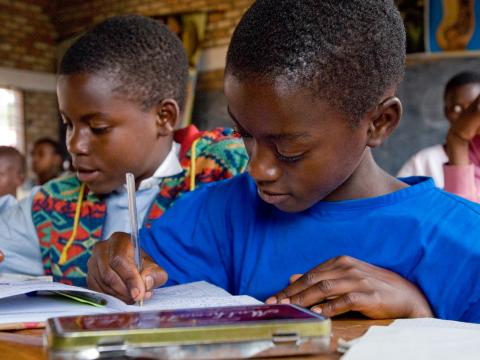Refugee Teachers: An Overlooked Resource for Peace

By Nancy Del Col, Education Sector Lead, World Vision Canada
This year’s International Day of Education calls attention to an urgent question in global education. What is the role of teachers and education systems in counteracting hate and promoting peace?
There are two main concepts of peace: negative peace (the tangible absence of war, conflict or violence) and positive peace (intentional transformation of relationships, institutions and structures that create and sustain peaceful societies). Teachers, especially refugee teachers, who have been displaced by conflict, can play a transformative role in creating positive peace within education systems in refugee camps and their host communities. However, they are an almost invisible or overlooked resource for achieving this.
Much focus is placed on vulnerable children in refugee camps to ensure they get access to learning in situations of displacement. However, according to UNHCR, 3.5 million school-aged refugee children received zero days of schooling in 2016. Still, the need for qualified, certified, well-resourced and supported teachers to teach these children is rarely considered. Qualified teachers lose their professional status in their new countries, receive lower pay and are often not considered in national planning for increasing and retaining the teacher workforce, fair remuneration or professional certification and development (UNHCR, 2023). This is despite us knowing that teachers are critical to the success of refugee children, not only ensuring the continuation of their learning but also providing them with a sense of routine, safety, security and belonging in a classroom or learning environment at a time of trauma, loss, and emotional stress due to migration or displacement.
Despite the relatively low investment in refugee teachers, much is expected of them, teaching not only academics but also addressing the psychological needs of traumatized students. According to UNICEF, refugee teachers are born out of necessity, not choice, and can feel anxious and overwhelmed by a skills-based curriculum, language barriers, unruly and disruptive students, little pedagogical training in child-centred teaching and learning, and their own personal traumas. Teaching knowledge, skills, attitudes, and values of peace and non-violent conflict resolution in such a context seems daunting and even impractical (Atkinson, 2023).
Egidia Umutesi is the Child Protection and Education Manager with World Vision Rwanda (WVR). She works with teachers in five refugee camps and two transition centres, hosting refugees from the Democratic Republic of Congo (DRC), Burundi, Libya and Somalia. WVR supports integrated schools between the camps and the host communities, where refugee teachers with or without qualifications can teach. Most teachers in the camps are young men and women, around 23 to 25 years old, who lack Rwandan citizenship but, in many cases, were born or grew up in the camps. They can speak English, the language of instruction, but have no other economic opportunities and lots of free time. Some are supported to get a teaching certification in Rwanda, says Egidia. However, “it’s challenging because they can’t compete for national (teaching) roles because they are not eligible,” so they can only teach in the integrated camp schools. The Ministry of Education sees refugee teachers as competition for Rwandan nationals and unreliable because they could be resettled in other countries, such as Canada. An overlooked resource, they desire to be integrated and considered in competition for national teaching jobs. WVR is working to capacitate them with teaching and learning skills in foundational literacy, numeracy and social-emotional skills and is advocating with district authorities to qualify them formally.
Peace gives comfort to the spirit. Peace guides, forgives and brings confidence to the worried or confused, and peace mends broken relationships with others. By supporting refugee teachers, we can comfort their own brokenness and build their capacity and confidence to guide their students toward a peaceful future.